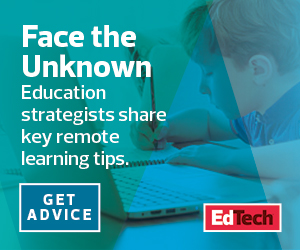In Shawnee Mission’s case, Lane says, the district may have been better situated for the transition than some thanks to its early adoption of Cisco Webex. SMSD, a district with 27,500 pre-K–12 students, has used the collaboration platform for about five years, primarily as a communication tool between departments for administrators. When the district implemented its plan for learning continuity after closing its school buildings, Webex “became the core component of that plan — the system we used to coordinate all of our efforts,” Lane says.
Those efforts, he explains, included deploying about 30,000 devices to students as well as offering training and informational sessions designed to help teachers provide digital instruction. Teachers had to get through a learning curve, he notes, but soon they achieved small successes, such as using a Webex translation app to deliver personalized content to students who are English language learners.
“It really is those pockets of silver lining that make me think we can figure this out,” Lane says. “Don’t get me wrong — technology won’t solve all our problems. But I think we have a suitable alternative for now.”
MORE ON EDTECH: Learn what drives or slows down remote learning.
The Future Impact of Remote Learning
Shawnee Mission administrators are not alone in warming to the potential for remote learning.
“Our superintendent has said many times that we turned 385 years of public education completely upside down in two weeks,” says Whitney Oakley, chief academic officer at Guilford County Schools in North Carolina. “What we have now is an opportunity to be innovative and to hopefully change the system for the better.”
At GCS, a district with about 73,000 students enrolled across 126 schools, the initial remote learning push focused primarily on student equity, Oakley says. “We have lots of areas of hypersegregated poverty, so we started with the basic needs, such as making sure kids had food.”
From there, GCS distributed thousands of devices, relying on donations from local philanthropic agencies to cover expenses, and staffers set up hotspots in safe public spaces, including school parking lots.
“These donated devices are computers that students get to keep,” Oakley says. Providing that connectivity remains the district’s biggest hurdle for remote learning, she says.












